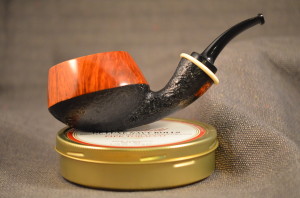Ok, I'll throw in my two cents here. Ebauchon blocks are cut closer to the center of the burl. That means the straight grain can fan out widely emanating from the center of the burl. The smaller the burl the wider the grain is fanned out. The grain also seems a bit more irregular on ebauchon blocks. The plateau, on the other hand, typically don't fan out so widely and can have more regular grain patterns. This makes it much easier to orient a shape that matches the grain on a piece of plateau than ebauchon briar. That is not to say it can't be done, but it is much easier with plateau.
For these reasons it is logical to use ebauchon blocks for classic shapes that do not rely on grain to dictate form. In those instances where you want a straight grained classic shape, you usually have to use a piece of plateau to create it.
As far as "reading" an ebauchon to maximize the grain, I personally see very little need to do so. That is not to say it isn't possible. I've done it. My first (and only) blowfish was cut from a piece of ebauchon. When you prep the block for work and sand down all the sides it's pretty easy to see what the grain is doing. But why try and go through all the trouble to read grain on a ebauchon when plateau is so much better for that kind of exercise.
In addition, I would add that in many instances it is not the carver that has the toughest time orienting the grain, but rather the briar cutter. A good cutter can maximize even the ebauchons to deliver phenomenal grain. I have multiple ebauchons that I bought from Mimmo that are darn near straight grain. He was able to cut the blocks in such a way to deliver that, and that takes much more talent than carving a pipe. So a good cutter can do all the hard work of orienting the grain. All the pipemaker has to do is carve.
Now I don't have near as much experience as some of the more seasoned carvers out here, but this has been my view. My opinions fluctuate on a practically daily basis depending on evidence so take what I'm saying with a grain of salt.

How is that for straight grain? This is a random ebauchon I got from Mimmo.

Here is my blowfish fashioned from a piece of ebauchon. This is just to show you that you can follow the grain of such a block if need be.



